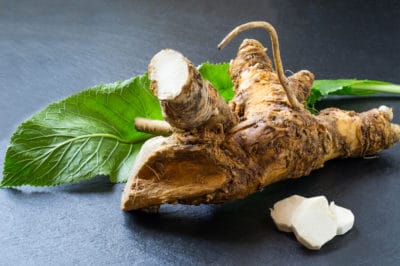About Horseradish
Horseradish is an invasive perennial plant. If you aren’t careful in your harvesting techniques, this pungent root will quickly take over more than its allotted space. Although the seeds are typically sterile, it quickly spreads by means of root stolons. When seeds aren’t sterile – which happens occasionally – the plant can quickly become a weedy nuisance.
Planning for Harvest
Careful planning and siting your horseradish plants properly can help when harvest time arrives. A loose soil makes it easier to dig the plants. Growing the plants as annuals or in a container decreases the risk that it will spread beyond your preferred limits. If you have close neighbors, you shouldn’t plant horseradish next to a shared fence, as the roots may travel under the fence.
USDA Zone and Harvest
Plan your harvest according to your USDA Zone. Mulch heavily and harvest earlier in the coldest zones.
- USDA Zone 1-4 – harvest in October and early November.
- USDA Zone 5-9 – harvest late November, December and possibly January.
- USDA Zones 10 and higher – if you can grow it at all, harvest in December.
Weather and Harvest
Horseradish will taste better if harvested after the weather cools. Cool weather and cool soil help the plant develop flavor from compounds that cause its typically peppery, pungent taste. Many people wait until the plant has gone through a couple of hard frosts before starting the harvest. However, don’t wait until the ground is frozen, as you won’t be able to get the roots out.
Winter Harvest
Even in cold climates, you can continue to harvest horseradish through the winter. The roots will store nicely in the soil. Mulch the plant heavily so the soil stays cool but doesn’t freeze. Plan on about 18 inches of old hay, straw or leaves over the top of the plant. Extend the mulch on both sides for a minimum of one foot. Pull the mulch aside to dig plants.
Early is Best
Don’t try to extend your harvest period too far into the spring. Harvesting in very early spring when the ground is still cold can be successful, but once the soil warms, the plant will start to grow again. The flavor of spring horseradish isn’t really that tasty, as the root compounds are different. Since this is also prime growing time, any small bit of root you miss is likely to sprout.
